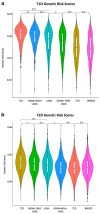The Genetic Architecture of Type 1 Diabetes
- PMID: 28829396
- PMCID: PMC5575672
- DOI: 10.3390/genes8080209
The Genetic Architecture of Type 1 Diabetes
Abstract
Type 1 diabetes (T1D) is classically characterised by the clinical need for insulin, the presence of disease-associated serum autoantibodies, and an onset in childhood. The disease, as with other autoimmune diseases, is due to the interaction of genetic and non-genetic effects, which induce a destructive process damaging insulin-secreting cells. In this review, we focus on the nature of this interaction, and how our understanding of that gene-environment interaction has changed our understanding of the nature of the disease. We discuss the early onset of the disease, the development of distinct immunogenotypes, and the declining heritability with increasing age at diagnosis. Whilst Human Leukocyte Antigens (HLA) have a major role in causing T1D, we note that some of these HLA genes have a protective role, especially in children, whilst other non-HLA genes are also important. In adult-onset T1D, the disease is often not insulin-dependent at diagnosis, and has a dissimilar immunogenotype with reduced genetic predisposition. Finally, we discuss the putative nature of the non-genetic factors and how they might interact with genetic susceptibility, including preliminary studies of the epigenome associated with T1D.
Keywords: Type 1; diabetes; genes; genetic.
Conflict of interest statement
The authors declare no conflict of interest.
Figures




References
Publication types
LinkOut - more resources
Full Text Sources
Other Literature Sources
Research Materials

